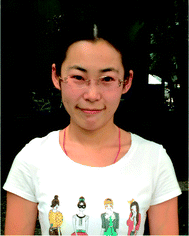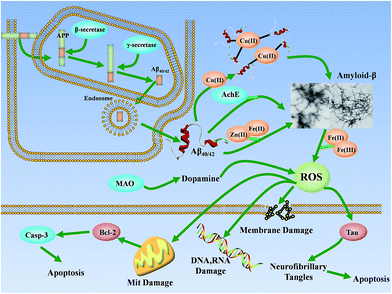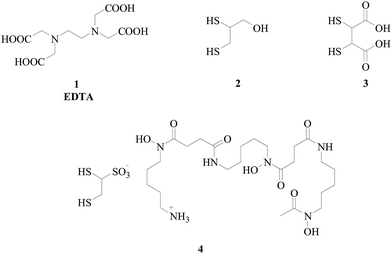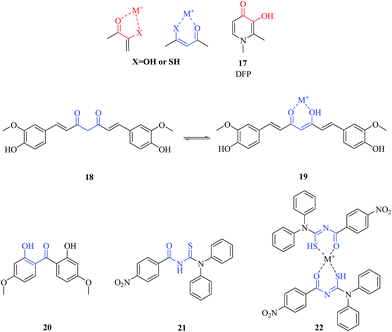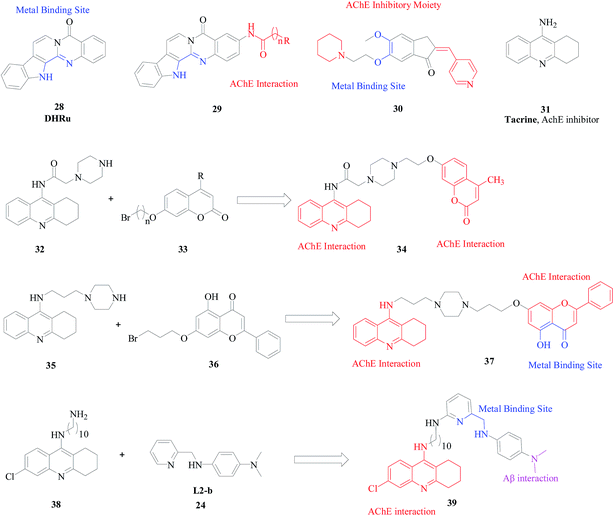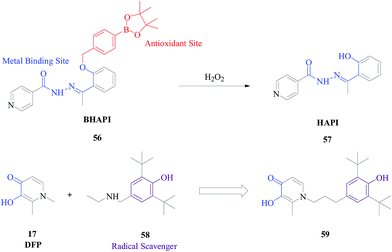Drug-like chelating agents: a potential lead for Alzheimer's disease
Wenhai Huang
,
Wenhua Wei
and
Zhengrong Shen
*
Institute of Materia Medica, Zhejiang Academy of Medical Sciences, 182 Tianmushan Road, West Lake District, Hangzhou, Zhejiang Province, China. E-mail: shenzr@zjams.com.cn; Fax: +86-571-88215625; Tel: +86-571-88215626
First published on 9th October 2014
Abstract
Recent evidence has indicated that dyshomeostasis of biometals (Fe, Cu, Zn) in the brain might contributes to the pathogenesis of Alzheimer's disease (AD). Experiments have also found that the level of metal ions in AD patients was 3–7 fold higher than that of healthy individuals. Many drug-like chelating agents were found to be able to reverse Aβ aggregation, dissolve amyloid plaques and delay the AD-related cognitive impairment. This review systematically discusses the drug-like chelating agents for AD as well as their potential applications in the future.
1. Introduction
Alzheimer's disease (AD), the leading cause of dementia in the elderly, is a complex neurodegenerative disorder. Until now, multiple factors, such as amyloid-β (Aβ) aggregation,1,2 metal dyshomeostasis, oxidative stress, mitochondrial dysfunction and reduced acetylcholine (ACh) level, have been considered to play an important role in the pathogenesis of AD.3 Recent evidence has indicated that dyshomeostasis of biometals (Fe, Cu, Zn) in the brain might contribute to AD pathogenesis.4 Experiments also found that the level of metal ions in AD patients was 3–7 folds higher than that of healthy individuals.5 Since drug-like chelating agents have the ability to reduce overloaded biometals, it has attracted more and more research interest. This review will systematically summarize the drug-like chelating agents for AD.1.1. Relationship between AD and metal ions
Besides of metal dyshomeostasis in AD patients, metal ions (such as Zn, Cu and Fe) are also associated closely with other pathological processes of AD, including Aβ aggregation and oxidative stress (Fig. 1).1.2. The feasibility of metal chelation therapy for AD
The dysregulation of metal ions in brain is one of the main factors in the pathogenesis of AD,34 and it is reasonable to treat this neurodegenerative disease with the strategy of metal chelation therapy. Studies on AD animal models have shown that genetic ablation of synaptic Zn greatly reduces the amount of amyloid plaques35 and several studies indicated that compounds reversing Zn homeostasis could affect Aβ deposition in the brain.18,19,36 Further, Desferrioxamine B (a drug used to treat Fe overload) significantly improved the behavioral and cognitive declines of AD patients.37 In addition, in vitro studies suggested that clioquinol (CQ, a classic metal chelator) prevented the formation of β-pleated sheets of Aβ and dissolved either synthetic preformed or AD brain-derived Aβ.38–40However, as anti-AD drug, a metal chelator should fulfill certain criteria such as moderate affinity for metals, efficient transport through biological membranes (especially blood brain barrier (BBB)), and low toxicity.41–44 Most of the chelators (Fig. 3), such as ethylenediaminetetraacetic acid (EDTA) (1), 2,3-dimercaptopropanol (2), meso-2,3-dimercaptosuccinic acid (3) and 2,3-dimercapto-1-propanesulfonate (4),45 cannot cross the BBB because of the large polar groups of OH, NH or SH in these compounds.43 To efficiently cross the BBB, the chelators should meet the ‘rule of 5’,46 while the substrates for biological transporters are exceptions to the rule. Therefore, how to balance this contradiction is a tremendous challenge in developing drug-like metal chelating agents against for AD.
In addition, the selectivity of promising metal chelators is also a big challenge. The chelating capability of chelators for AD should strong enough to catch the free metal ions or the metal ions bound to Aβ, while it is insufficient to compete with the metal ions bound to the other metalloproteins which may play an important function in human. Fortunately, according to the binding affinity test in vitro, the log![[thin space (1/6-em)]](https://www.rsc.org/images/entities/char_2009.gif) KCu(II) and log
KCu(II) and log![[thin space (1/6-em)]](https://www.rsc.org/images/entities/char_2009.gif) KZn(II) of Aβ are in the range of 7–11 and 5–6 respectively depending on the experiment condition,47 which is lower than that of metalloproteins (such as metallothioneins, the log
KZn(II) of Aβ are in the range of 7–11 and 5–6 respectively depending on the experiment condition,47 which is lower than that of metalloproteins (such as metallothioneins, the log![[thin space (1/6-em)]](https://www.rsc.org/images/entities/char_2009.gif) KCu(II) and log
KCu(II) and log![[thin space (1/6-em)]](https://www.rsc.org/images/entities/char_2009.gif) KZn(II) of which are 11 and 18 respectively). Therefore, a promising chelator for AD should meet the follow rules: log
KZn(II) of which are 11 and 18 respectively). Therefore, a promising chelator for AD should meet the follow rules: log![[thin space (1/6-em)]](https://www.rsc.org/images/entities/char_2009.gif) KAβ < log
KAβ < log![[thin space (1/6-em)]](https://www.rsc.org/images/entities/char_2009.gif) Kchelator < log
Kchelator < log![[thin space (1/6-em)]](https://www.rsc.org/images/entities/char_2009.gif) Kmetalloproteins.
Kmetalloproteins.
2. Potential drug-like agent for AD
2.1. Single-target-directed ligand
Although numerous chelating agents exist, only a few compounds with favorable pharmacological effects could be used as an anti-Alzheimer's drug. Because of the low MW and rigid scaffold, clioquinol (CQ) and deferiprone (DFP) have been considered as the potential leads against Alzheimer's disease.![[thin space (1/6-em)]](https://www.rsc.org/images/entities/char_2009.gif) :
:![[thin space (1/6-em)]](https://www.rsc.org/images/entities/char_2009.gif) 1, thus interdicting metal-ion from binding to Aβ and dissolving brain deposits in vitro.49 These intriguing results shed instructive light on partly reversing the AD progress by metal chelating agents. A pilot phase IIa clinical trial of CQ in AD patients showed that it could slow cognitive deterioration and significantly lower plasma Aβ42 levels.50 Unfortunately, due to the possible neurotoxicity and unacceptable mutagenic impurities the development of CQ as anti-Alzheimer's drug has suspended.19,51
1, thus interdicting metal-ion from binding to Aβ and dissolving brain deposits in vitro.49 These intriguing results shed instructive light on partly reversing the AD progress by metal chelating agents. A pilot phase IIa clinical trial of CQ in AD patients showed that it could slow cognitive deterioration and significantly lower plasma Aβ42 levels.50 Unfortunately, due to the possible neurotoxicity and unacceptable mutagenic impurities the development of CQ as anti-Alzheimer's drug has suspended.19,51PBT2, a second-generation 8-OH quinoline derivative of CQ without iodine atom, has been developed as anti-Alzheimer's drug. It has also been shown to prevent production of Aβ oligomers, dissolve the existing Aβ oligomers, and enhance cognitive function in transgenic mice.19 It appears to be safe and well tolerated in people with mild Alzheimer's dementia,40 and it has completed the phase IIa trial in AD patients.52 Unfortunately, the results of Phase II IMAGINE trial of PBT2 showed that there is no statistically significant decrease of the Aβ levels in mild AD patients.
A bis-8-hydroxyquinoline ligand 6, containing two linked 8-hydroxyquinolines which is active in a 1![[thin space (1/6-em)]](https://www.rsc.org/images/entities/char_2009.gif) :
:![[thin space (1/6-em)]](https://www.rsc.org/images/entities/char_2009.gif) 1 ratio chelation with the metal ion,53 allowed significant increases in the ability to protect against β-amyloid peptide precipitation in the presence of Cu(II), Zn(II) and Fe(III) compared to CQ in vitro. It can also inhibit the production of H2O2 induced by Cu–Aβ, which is associated with toxic oxidative stress in AD. Further study showed that substitutions of the methylene hydrogens of 6 by two methyl groups or a keto function (7, 8 as show in Fig. 4) induced only a limited decrease of their activity and these chelators are less susceptible to an oxidative metabolism in vivo. In addition, introduction of substituents such as chloride, iodide or methyloxy on 8-hydroxyquinoline heterocycle had a negative effect in activity experiments.54 Furthermore, the affinity of bis-8-hydroxyquinoline compounds for Cu(II) and Zn(II) had also been estimated. Most of them showed similar affinity with log
1 ratio chelation with the metal ion,53 allowed significant increases in the ability to protect against β-amyloid peptide precipitation in the presence of Cu(II), Zn(II) and Fe(III) compared to CQ in vitro. It can also inhibit the production of H2O2 induced by Cu–Aβ, which is associated with toxic oxidative stress in AD. Further study showed that substitutions of the methylene hydrogens of 6 by two methyl groups or a keto function (7, 8 as show in Fig. 4) induced only a limited decrease of their activity and these chelators are less susceptible to an oxidative metabolism in vivo. In addition, introduction of substituents such as chloride, iodide or methyloxy on 8-hydroxyquinoline heterocycle had a negative effect in activity experiments.54 Furthermore, the affinity of bis-8-hydroxyquinoline compounds for Cu(II) and Zn(II) had also been estimated. Most of them showed similar affinity with log![[thin space (1/6-em)]](https://www.rsc.org/images/entities/char_2009.gif) KCu(II) ≈ 16 and log
KCu(II) ≈ 16 and log![[thin space (1/6-em)]](https://www.rsc.org/images/entities/char_2009.gif) KZn(II) ≈ 13 which are several order of magnitudes stronger than Aβ. Among a series of bis-quinolines derivatives (9 in Fig. 4),54,55 PA1637, the structure of which is unknown, showed high selectivity for Cu(II) with log
KZn(II) ≈ 13 which are several order of magnitudes stronger than Aβ. Among a series of bis-quinolines derivatives (9 in Fig. 4),54,55 PA1637, the structure of which is unknown, showed high selectivity for Cu(II) with log![[thin space (1/6-em)]](https://www.rsc.org/images/entities/char_2009.gif) K value of 17.9 and incapacity for Zn(II). It is gratifying that PA1637 could fully reverse the deficit of episodic memory after three weeks of treatment by oral on non-transgenic amyloid-impaired mice.56 According to bioisosterism, replacement of the oxygen atom in binding site by sulfur atom is also a possible way to design new compound for neurodegenerative diseases. Chelating agent 10 (2-(2,4-dichlorobenzylideneamino)benzenethiol), containing N and S as binding sites, had been used to chelate Cu(II), Fe(III), and Zn(II) ions.57
K value of 17.9 and incapacity for Zn(II). It is gratifying that PA1637 could fully reverse the deficit of episodic memory after three weeks of treatment by oral on non-transgenic amyloid-impaired mice.56 According to bioisosterism, replacement of the oxygen atom in binding site by sulfur atom is also a possible way to design new compound for neurodegenerative diseases. Chelating agent 10 (2-(2,4-dichlorobenzylideneamino)benzenethiol), containing N and S as binding sites, had been used to chelate Cu(II), Fe(III), and Zn(II) ions.57
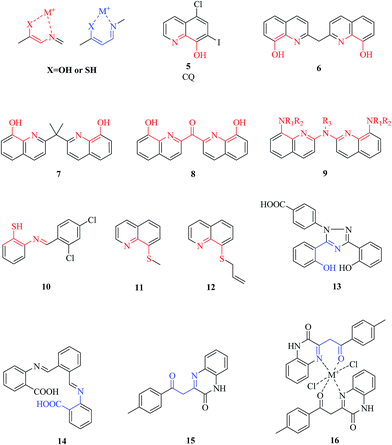 | ||
| Fig. 4 The structure of CQ and classical CQ analogues chelating group with O (or its main group element S) and N atoms as the binding sites. | ||
Interestingly, a new strategy was developed to find chelators with suitable pharmacokinetic properties. As a start, bioisosterism was used to design the 11 (8-(allylthio)quinoline) as core scaffold, which replaced the oxygen atom in CQ by a sulfur atom. Since the computed ΔGsol of the complexes of [Cu(L)2]2+ is more negative than [Zn(L)2]2+, the chelation of 11 is more favourable for Cu(II). Furthermore, by searching the commercial compounds that contain the 11 structure from different databases via virtual screening, 12, a possible metal chelator candidate with potential applications in AD, was selected and its ability to transfer the BBB had been identified. This method combining rational design and in silico virtual screening is the rapid way to search the drug-like chelators for AD.58
Deferasirox 13 (4-[3,5-bis-(2-hydroxyphenly)-1,2,4-triazol-1-yl]-benzoic acid) is an old drug in marketing for more than 50 years for treating transfusional iron overload in thalassemia major patients. The metal ion and chelating group containing hydroxyl group and N atom formed a stable six-member ring. It selectively binds Fe(II) and Fe(III) (log![[thin space (1/6-em)]](https://www.rsc.org/images/entities/char_2009.gif) K = 30.6) and shows little affinity for other essential divalent metals.45,59
K = 30.6) and shows little affinity for other essential divalent metals.45,59
Mohamed et al. reported 14 (2,2′-(1E,1′E)-(1,2-phenylenebis(methan-1-yl-1-ylidene)) bis (azan-1-yl-1-ylidene)dibenzoic acid), which is coordinated to the metal ions with the azomethine-N and carboxylate-O as the binding site by the ratio of 1![[thin space (1/6-em)]](https://www.rsc.org/images/entities/char_2009.gif) :
:![[thin space (1/6-em)]](https://www.rsc.org/images/entities/char_2009.gif) 1. The structures of complexes of 14 with Cu(II), Zn(II) and Fe(III) ions were confirmed by the magnetic and solid reflectance, and the geometrical structure are found to be octahedral (Fe(III)) and square planar (Cu(II) and Zn(II)). The authors also reported their antimicrobial activity against different species of bacteria and fungi.60
1. The structures of complexes of 14 with Cu(II), Zn(II) and Fe(III) ions were confirmed by the magnetic and solid reflectance, and the geometrical structure are found to be octahedral (Fe(III)) and square planar (Cu(II) and Zn(II)). The authors also reported their antimicrobial activity against different species of bacteria and fungi.60
An Egypt group disclosed a quinoxaline ligand 15 (3-(2-oxo-2-p-tolylethyl)quinoxalin-2(1H)-one) with N and O donation sites. Compound 16, the chelating complexes of 15 with metal (Cu(II) and Zn(II)), are found to have octahedral structure. In order to assess the selectivity of 15, the ligand–metal stability constants showed that the order of stability constants is in accordance with irving-williams order (log![[thin space (1/6-em)]](https://www.rsc.org/images/entities/char_2009.gif) KMn(II) = 7.95 < log
KMn(II) = 7.95 < log![[thin space (1/6-em)]](https://www.rsc.org/images/entities/char_2009.gif) KCo(II) = 9.31 < log
KCo(II) = 9.31 < log![[thin space (1/6-em)]](https://www.rsc.org/images/entities/char_2009.gif) KNi(II) = 10.54 < log
KNi(II) = 10.54 < log![[thin space (1/6-em)]](https://www.rsc.org/images/entities/char_2009.gif) KCu(II) = 10.75 > log
KCu(II) = 10.75 > log![[thin space (1/6-em)]](https://www.rsc.org/images/entities/char_2009.gif) KZn(II) = 9.75).61
KZn(II) = 9.75).61
![[thin space (1/6-em)]](https://www.rsc.org/images/entities/char_2009.gif) K = 36.34),63 copper and zinc.64 Although the C
K = 36.34),63 copper and zinc.64 Although the C![[thin space (1/6-em)]](https://www.rsc.org/images/entities/char_2009.gif) log
log![[thin space (1/6-em)]](https://www.rsc.org/images/entities/char_2009.gif) P value of DFP is −1.4, which is too low to cross BBB, its low molecular weight (MW = 139) and suitable structure make DFP more easily to optimize,65 and it has been considered as a lead compound to design multi-target directed ligand (MTDL) for treating AD (described in detail later).66,67
P value of DFP is −1.4, which is too low to cross BBB, its low molecular weight (MW = 139) and suitable structure make DFP more easily to optimize,65 and it has been considered as a lead compound to design multi-target directed ligand (MTDL) for treating AD (described in detail later).66,67Curcumin 18, which may be useful for prevention and treatment of several diseases, can exist in two tautomeric forms (including a 1,3-diketoform and two equivalent enol forms). It has been demonstrated that the enol form, which is more energetically stable in the solid phase and in solution, possesses a good chelating ability to chelate Zn(II) and Cu(II) under synthetic conditions.68 As reported, curcumin has ability to scavenge free-radical by its phenol-OH group, producing a very stable resultant phenoxyl radical because of its extended conjugation structure69 as the following reaction in Fig. 6.69
 | ||
| Fig. 6 Curcumin scavenges free-radical by its phenol-OH group, producing a very stable resultant phenoxyl radical. | ||
In addition, Zn(II)–curcumin complex and Cu(II)–curcumin complex can also scavenge free-radical. Moreover, Cu(II)–curcumin complex has a stronger ability of scavenging free radical than curcumin and Zn(II)–curcumin complex. The results may enhance comprehension for the curcumin roles in the AD treatment.68,70–73 Futhermore, curcumin treatment of an Alzheimer transgenic APPSw mouse model (Tg2576) for 6 months resulted in a suppression of indices of inflammation and oxidative damage in the brains of these mice with fewer side effects and toxicity issues.74 Therefore, curcumin or another combined antioxidant/NSAID approach may prove useful for AD prevention or treatment.75
Benzophenone derivatives are widely used in plastics, sunscreen, and cosmetic applications and are often present in conjunction with transition metal oxide supports. Metal ions and 20 (bis(2-hydroxy-4-methoxyphenyl)methanone) with O donation sites formed a stable six-member ring.76
Thioureas have a long history as a ligand in coordination chemistry. Saeed reported compound 21 (N-(diphenylcarbamothioyl)-4-nitrobenzamide), which can chelate Ni(II) and Cu(II) via sulfur and oxygen atoms.77 Similar to curcumin, 21 coordinate as bidentates yielding essentially neutral complexes of the type [ML2]. The 21-metal complexes were screened for their in vitro biological activity and showed greater antibacterial activity.78
2.2. Multi-target-directed ligand (MTDL)
Due to the pathological complexity of AD, single drug on a specific target might not be enough to produce the desired clinical effects. Thus, MTDL with two or more complementary biological activities are much needed in the anti-AD drug development.79–81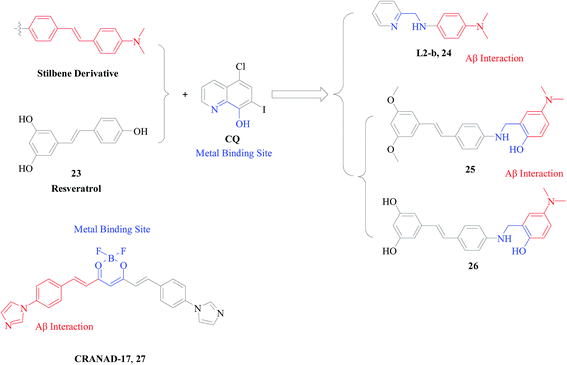 | ||
| Fig. 7 Chemical structures of molecules having bifunctionality (metal chelation and Aβ interaction). | ||
Resveratrol is a naturally occurring product with a stilbene structure, which has been widely studied for its broad range of biological activities. Recent evidence has suggested that resveratrol functions as an anti-AD agent with the ability to inhibit Aβ aggregation by scavenging oxidants and exerting anti-inflammatory activities.83,84 Animal experiments have suggested that resveratrol is also effective in prevention of neurodegenerative diseases.85,86 Currently, a phase II clinical trial is undergoing on AD.87 Xingshu Li group combined resveratrol and the pharmacophore moiety of the aforementioned well-known metal chelator CQ and obtained a novel series of derivatives. In vitro studies showed that most of the novel derivatives had significant inhibition of self- and Cu(II)-induced Aβ aggregation, potential antioxidants properties and biometal chelating properties. Specifically, compounds 25 and 26 were the most potential (Fig. 7). Furthermore, compound 25 had the ability to cross the BBB in vitro and did not show any acute toxicity in mice at doses of up to 2000 mg kg−1.88
However, all of the reported chelators have one obvious and potential side effect of disruption of brain metal homeostasis after a prolonged treatment.89,90 Before reaching the targeting region, they could sequester or seize metal ions that may be essential for normal brain functions. According to the limited interaction mechanism of the designed imaging probe with Aβ and its fragments, Chongzhao Ran group designed and synthesized a curcumin analogue called CRANAD-17 (27), in which the curcumin scaffold acted as an a nchoring moiety to guide 27 to the vicinity of H13 and H14 of Aβ, and the imidazole rings bound copper competing with H13/H14 within Aβ. Compared to the traditional chelators, 27 is monodentate and the disruption of brain metal homeostasis by 27 would be minimal. With the ability of inhibiting Aβ42 cross-linking induced by copper, 27 seems promising and might be considered for AD therapy.91
Compound 30 (Fig. 8), which contained a piperidine group linked to indanone by a two-carbon spacer, exhibited inhibitory activity, with an IC50 value of 0.0018 μM against acetylcholine enzyme (AChE). The pyridinylmethylene group in these compounds was very important for the inhibitory activity and the double bond was crucial for the activity as well. It was also reported as a metal chelator, however, the chelating group of 30 may have weak action with metal ions.96
Tacrine (31, the first ChE inhibitor) approved by the FDA for AD treatment in 1993,97 was withdrawn from the market due to severe liver toxicity.98 However, with increased research interest in hybrid or multitarget compounds in order to obtain potent AChE inhibitors with other pharmacological properties, tacrine has become a widely used scaffold in recent years.99,100 Tacrine can inhibit both ChEs with potency in nanomolar range, More importantly, because tacrine has a relatively low molecular weight, it is suitable for further modification. The easiest way is to combine tacrine and other fragments with additional biological activities through an appropriate linker to produce multifunctional ChE inhibitors such as tacrine–melatonin hybrids and tacrine–ferulic acid hybrids.101,102 Recently, coumarins and flavonoids, the naturally occurring compounds, have drawn increasingly attentions due to their potential applications in a wide range of pharmacological properties related to a variety of neurodegenerations, especially for AD.103–107
Ling-Yi Kong group designed and synthesized two series of hybrids, and the results indicating that most of the compounds, especially compounds 34 (the hybrids of 32 and 33) and 37 (the hybrids of 35 and 36) were highly potential and showed a significant ability against ChE and self-induced Aβ1–42 aggregation (Fig. 8). Moreover, both also function as excellent metal chelators, with low cell toxicity for compound 37.102,108
As described before, compound 24, an ideal chelator for Cu(II) and Zn(II), effectively regulates metal-induced Aβ aggregation and neurotoxicity in vitro and in human neuroblastoma cells.82 Sylvie Garneau-Tsodikova group chemically bound the metal–Aβ modulator 24 with 6-chlorotacrine 38, thus creating a hybrid molecule (39) potentially capable of multifunctionality. It shows potent AChE inhibition under various conditions, interacts with Cu(II) and Zn(II), controls metal-free and metal-induced Aβ aggregations assembly, and disaggregates preformed metal-free and metal-associated Aβ aggregations (Fig. 8).109
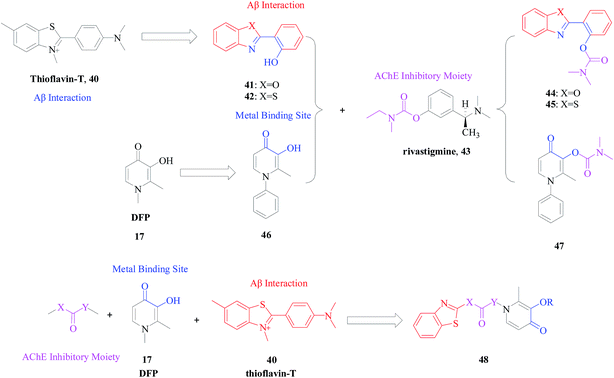 | ||
| Fig. 9 Chemical structures of molecules having trifunctionality (metal chelation, AChE interaction and Aβ interaction). | ||
46 was inspired by the excellent molecular scaffold of DFP.62 It is a potent metal chelator with antioxidant activity, low toxicity and ability to degradate Aβ deposits in the presence of metal ions.110,111 Studies showed that a glycoconjugate prodrug derivative of 46 performed adequate BBB permeability.112 2-(2-hydroxyphenyl)benzoxazole (41) and 2-(2-hydroxyphenyl)-benzothiazole (42) were derived from thioflavin-T (the traditional histological dye) and the aforementioned ligand CQ, representing the properties of their originally designed precursors.113 Not only did both compounds exhibit similar binding abilities to CQ, but they also showed the ability to interact with Aβ aggregations.113 In an attempt to augment the functionality of the three aforementioned molecules (41, 42 and 46), they were O-derivatived with a carbamate moiety (the active group of rivastigmine 43, an AD drug currently in the market). The novel multifunctional prodrugs (44, 45 and 47) for potential use in AD treatment were synthesized and characterized. Compared to the parent molecules (41, 42 and 46), the inhibitory effect of the prodrugs (44, 45 and 47) indicates that it is a significant effect to incorporate a carbamate moiety to their structure (Fig. 9).62
The extrafunctionalization of DFP with benzothiazole 40 is based on its known strong affinity for amyloid fibrils and application in Aβ imaging probes.114 The linker between the two basic fragments was designed to provide the whole molecule with capability for the inhibition of AChE. Following this strategy, Amélia Santos group prepared a set of four hybrids (3-hydroxy-4-pyridinone)-benzothiazole chelators and 3-hydroxy-4-pyridinone-O-benzyl analogues (48). This set of hybrid hydroxypyridinone–benzothiazole chelators and derivatives could merge important properties, such as iron-chelation (high ability to form tris-chelated complexes), anti-oxidant activity, AChE inhibition and interaction with Aβ. Some of them required further studies for AD drug treatment (Fig. 9).115
Most benzylideneindanone derivatives exhibited multifunctional activity as potential anti-AD drugs, which included significant ability to inhibit self-induced Aβ aggregation and MAO-B activity and act as antioxidants and biometal chelators. Among the synthesized compounds, 52 gave the greatest inhibitory potency toward self-induced Aβ aggregation. Compound 52 not only was a potent biometal chelator by inhibiting Cu(II)-induced Aβ aggregation, but also could disassemble the well structured Aβ fibrils (Fig. 10).118
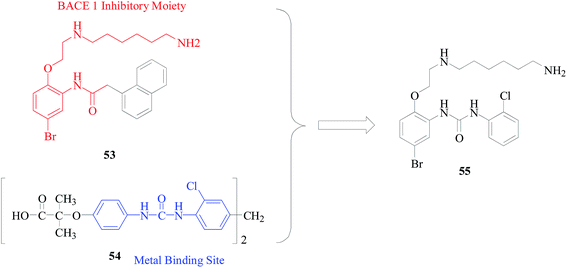 | ||
| Fig. 11 Chemical structures of molecules having bifunctionality (metal chelation and BACE inhibition). | ||
Compound 59 achieved its neuroprotective effect via inhibition of oxidative stress and displayed a superior neuroprotective action compared to the dual administration of the radical scavenger 58,121 and the iron chelator DFP,122 which slowed the clinical progression of the dementia associated with AD with sustained intramuscular administration.37 Compounds of this series are currently under evaluation for the treatment of neurodegenerative disorders (Fig. 12).123
3. Discussion
Metal ions play important roles in amyloid aggregation12,14 and neurotoxicity.124–127 Metal-ion chelation therapy has been used in clinical trials for AD treatment. However, clinical trial studies have shown that long-term use of metal chelator can cause adverse side effect, subacute myelo-optic neuropathy. At the same time, most of the chelators cannot cross the blood brain barrier (BBB)43 and are unable to specifically target metal ions in various Aβ forms without removing vital metals from other biological systems due to lack of Aβ recognition/interaction ability.128 To overcome these impediments, some other molecular design approaches have been introduced based on physiological environment. For example, prochelators have been designed for the purpose of easily entering the BBB.112 The functional groups of the prochelators are then activated by enzymatic or non-enzymatic reactions only after they have entered the target organ.129–132 Moreover, bifunctional molecules containing both amyloid-binding and metal-chelating moieties were also designed.82,113,133 However, no clear clinical evidence for the bifunctional effect on AD has been demonstrated, and much effort is still needed to design efficiently controlled-release system.134 Nanoparticles ranging in size from about 10–1000 nm present a possible tool to transport drugs across the BBB. These insights into nanoparticle transport have lent a strong impetus to chelation therapy in AD.135,1364. Conclusion
Metal dyshomeostasis as a pathogenic factor for AD has attracted increasing attention in recent years. Therapeutic strategies are investigated to restore metal ion homeostasis in the brain of both AD patients and AD transgenic mice, thus reversing Aβ aggregation, dissolving amyloid plaques and delaying the AD-related cognitive impairment. Many drug-like chelating agents, such as Clioquinol, PBT2, M30 and other 8-hydroxyquinoline analogues, were found to have the ability attenuating Aβ aggregation and oxidative stress. Such compounds thereby are worth further study for their clinical application in AD. For the complex pathology of AD, multi-target-directed ligand (MTDL) appears to be more efficient compound in the treatment of AD in the future.Conflict of interest
The author(s) confirm that this article content has no conflicts of interest.Abbreviations
| Aβ | Amyloid-β |
| ACh | Acetylcholine |
| AChE | Acetylcholine enzyme |
| AD | Alzheimer's disease |
| APP | Amyloid beta precursor protein |
| BBB | Blood–brain-barrier |
| ChE | Choline enzyme |
| CQ | Clioquinol |
| DFP | Deferiprone |
| EDTA | Ethylenediaminetetraacetic acid |
| MAO | Monoamine oxidase |
| MTDL | Multi-target-directed ligand |
| MW | Molecular weight |
| ROS | Reactive oxygen species |
Acknowledgements
The authors thank the National Natural Science Foundation of China (81302646), Natural Science Foundation of Zhejiang Province (LQ13H300002), Science Technology Department of Zhejiang Province (2015F50015 and 2012F10005) and Health and Family Planning commission of Zhejiang Province (XKQ-01001, 2012RCB009 and 2013KYB070) for financial support.Notes and references
- A. K. Ghosh, N. Kumaragurubaran and J. Tang, Curr. Top. Med. Chem., 2005, 5, 1609–1622 CrossRef CAS.
- T. Guo and D. W. Hobbs, Curr. Med. Chem., 2006, 13, 1811–1829 CrossRef CAS.
- H. Y. Zhang, FEBS Lett., 2005, 579, 5260–5264 CrossRef CAS PubMed.
- S. Mandel, T. Amit, O. Bar-Am and M. B. Youdim, Prog. Neurobiol., 2007, 82, 348–360 CrossRef CAS PubMed.
- P. Zatta, D. Drago, S. Bolognin and S. L. Sensi, Trends Pharmacol. Sci., 2009, 30, 346–355 CrossRef CAS PubMed.
- H. Josien, Curr. Opin. Drug Discovery Dev., 2002, 5, 513–525 CAS.
- V. John, J. P. Beck, M. J. Bienkowski, S. Sinha and R. L. Heinrikson, J. Med. Chem., 2003, 46, 4625–4630 CrossRef CAS PubMed.
- A. Y. Kornilova and M. S. Wolfe, Annu. Rep. Med. Chem., 2003, 38, 41–50 CAS.
- J. Hardy and D. J. Selkoe, Science, 2002, 297, 353–356 CrossRef CAS PubMed.
- A. I. Bush, J. Alzheimer's Dis., 2008, 15, 223–240 CAS.
- M. Lovell, J. Robertson, W. Teesdale, J. Campbell and W. Markesbery, J. Neurol. Sci., 1998, 158, 47–52 CrossRef CAS.
- A. I. Bush, W. H. Pettingell, G. Multhaup, M. Paradis, J. P. Vonsattel, J. F. Gusella, K. Beyreuther, C. L. Masters and R. E. Tanzi, Science, 1994, 265, 1464–1467 CAS.
- K. H. Lim, Y. K. Kim and Y. T. Chang, Biochemistry, 2007, 46, 13523–13532 CrossRef CAS PubMed.
- C. S. Atwood, R. D. Moir, X. Huang, R. C. Scarpa, N. M. E. Bacarra, D. M. Romano, M. A. Hartshorn, R. E. Tanzi and A. I. Bush, J. Biol. Chem., 1998, 273, 12817–12826 CrossRef CAS PubMed.
- X. Huang, C. S. Atwood, R. D. Moir, M. A. Hartshorn, R. E. Tanzi and A. I. Bush, J. Biol. Inorg. Chem., 2004, 9, 954–960 CrossRef CAS PubMed.
- G. McColl, B. R. Roberts, A. P. Gunn, K. A. Perez, D. J. Tew, C. L. Masters, K. J. Barnham, R. A. Cherny and A. I. Bush, J. Biol. Chem., 2009, 284, 22697–22702 CrossRef CAS PubMed.
- F. Bousejra-ElGarah, C. Bijani, Y. Coppel, P. Faller and C. Hureau, Inorg. Chem., 2011, 50, 9024–9030 CrossRef CAS PubMed.
- R. A. Cherny, C. S. Atwood, M. E. Xilinas, D. N. Gray, W. D. Jones, C. A. McLean, K. J. Barnham, I. Volitakis, F. W. Fraser and Y. S. Kim, Neuron, 2001, 30, 665–676 CrossRef CAS.
- P. A. Adlard, R. A. Cherny, D. I. Finkelstein, E. Gautier, E. Robb, M. Cortes, I. Volitakis, X. Liu, J. P. Smith and K. Perez, Neuron, 2008, 59, 43–55 CrossRef CAS PubMed.
- C. Opazo, M. I. Barría, F. H. Ruiz and N. C. Inestrosa, BioMetals, 2003, 16, 91–98 CrossRef CAS.
- D. J. Bonda, H. G. Lee, J. A. Blair, X. Zhu, G. Perry and M. A. Smith, Metallomics, 2011, 3, 267–270 RSC.
- M. Smith, G. P. P. Richey, L. Sayre, V. Anderson, M. Beal and N. Kowall, Nature, 1996, 382, 120–121 CrossRef CAS PubMed.
- L. M. Sayre, D. A. Zelasko, P. L. Harris, G. Perry, R. G. Salomon and M. A. Smith, J. Neurochem., 1997, 68, 2092–2097 CrossRef CAS.
- A. Nunomura, G. Perry, M. A. Pappolla, R. Wade, K. Hirai, S. Chiba and M. A. Smith, J. Neurosci., 1999, 19, 1959–1964 CAS.
- S. Varadarajan, S. Yatin, M. Aksenova and D. A. Butterfield, J. Struct. Biol., 2000, 130, 184–208 CrossRef CAS PubMed.
- R. J. Castellani, K. Honda, X. Zhu, A. D. Cash, A. Nunomura, G. Perry and M. A. Smith, Ageing. Res. Rev., 2004, 3, 319–326 CrossRef CAS PubMed.
- X. Zhu, A. K. Raina, H. G. Lee, G. Casadesus, M. A. Smith and G. Perry, Brain Res., 2004, 1000, 32–39 CrossRef CAS PubMed.
- K. Jomova, S. Baros and M. Valko, Transition Met. Chem., 2012, 37, 127–134 CrossRef CAS PubMed.
- S. I. Liochev and I. Fridovich, Redox Rep., 2002, 7, 55–57 CrossRef CAS PubMed.
- J. Prousek, Pure Appl. Chem., 2007, 79, 2325–2338 CrossRef CAS.
- K. Jomova, D. Vondrakova, M. Lawson and M. Valko, Mol. Cell. Biochem., 2010, 345, 91–104 CrossRef CAS PubMed.
- C. S. Atwood, R. C. Scarpa, X. Huang, R. D. Moir, W. D. Jones, D. P. Fairlie, R. E. Tanzi and A. I. Bush, J. Neurochem., 2000, 75, 1219–1233 CrossRef CAS.
- C. S. Atwood, G. Perry, H. Zeng, Y. Kato, W. D. Jones, K. Q. Ling, X. Huang, R. D. Moir, D. Wang and L. M. Sayre, Biochemistry, 2004, 43, 560–568 CrossRef CAS PubMed.
- S. Pfaender and A. M. Grabrucker, Metallomics, 2014, 6, 960–977 RSC.
- J. Y. Lee, T. B. Cole, R. D. Palmiter, S. W. Suh and J. Y. Koh, Proc. Natl. Acad. Sci. U. S. A., 2002, 99, 7705–7710 CrossRef CAS PubMed.
- J. Y. Lee, J. E. Friedman, I. Angel, A. Kozak and J. Y. Koh, Neurobiol. Aging, 2004, 25, 1315–1321 CrossRef CAS PubMed.
- D. C. McLachlan, T. Kruck, W. Kalow, D. Andrews, A. Dalton, M. Bell and W. Smith, Lancet, 1991, 337, 1304–1308 CrossRef.
- E. House, J. Collingwood, A. Khan, O. Korchazkina, G. Berthon and C. Exley, J. Alzheimer's Dis., 2004, 6, 291–301 CAS.
- S. R. Bareggi and U. Cornelli, CNS Neurosci. Ther., 2012, 18, 41–46 CrossRef CAS PubMed.
- E. Sampson, L. Jenagaratnam and R. McShane, Cochrane Database of Systematic Reviews, 2008, 1, 1–12 Search PubMed.
- D. S. Kalinowski and D. R. Richardson, Chem. Res. Toxicol., 2007, 20, 715–720 CrossRef CAS PubMed.
- A. Dairam, R. Fogel, S. Daya and J. L. Limson, J. Agric. Food Chem., 2008, 56, 3350–3356 CrossRef CAS PubMed.
- W. M. Pardridge, Alzheimer's Dementia, 2009, 5, 427–432 CrossRef PubMed.
- P. Bendova, E. Mackova, P. Haskova, A. Vavrova, E. Jirkovsky, M. Sterba, O. Popelova, D. S. Kalinowski, P. Kovarikova and K. Vavrova, Chem. Res. Toxicol., 2010, 23, 1105–1114 CrossRef CAS PubMed.
- E. J. Baran, Curr. Med. Chem., 2010, 17, 3658–3672 CrossRef CAS.
- C. A. Lipinski, F. Lombardo, B. W. Dominy and P. J. Feeney, Adv. Drug Delivery Rev., 1997, 23, 3–25 CrossRef CAS.
- P. Faller and C. Hureau, Dalton Trans., 2009, 40, 1080–1094 RSC.
- B. Regland, W. Lehmann, I. Abedini, K. Blennow, M. Jonsson, I. Karlsson, M. Sjögren, A. Wallin, M. Xilinas and C. G. Gottfries, Dementia Geriatr. Cognit. Disord., 2001, 12, 408–414 CrossRef CAS PubMed.
- E. Ferrada, V. Arancibia, B. Loeb, E. Norambuena, C. Olea-Azar and J. P. Huidobro-Toro, Neurotoxicology, 2007, 28, 445–449 CrossRef CAS PubMed.
- C. W. Ritchie, A. I. Bush, A. Mackinnon, S. Macfarlane, M. Mastwyk, L. MacGregor, L. Kiers, R. Cherny, Q. X. Li and A. Tammer, Arch. Neurol., 2003, 60, 1685–1691 CrossRef PubMed.
- A. Budimir, Acta Pharm., 2011, 61, 1–14 CrossRef CAS PubMed.
- L. Lannfelt, K. Blennow, H. Zetterberg, S. Batsman, D. Ames, J. Harrison, C. L. Masters, S. Targum, A. I. Bush and R. Murdoch, Lancet Neurol., 2008, 7, 779–786 CrossRef CAS.
- C. Deraeve, M. Pitié, H. Mazarguil and B. Meunier, New J. Chem., 2007, 31, 193–195 RSC.
- C. Deraeve, C. Boldron, A. Maraval, H. Mazarguil, H. Gornitzka, L. Vendier, M. Pitie and B. Meunier, Chem.–Eur. J., 2008, 14, 682–696 CrossRef CAS PubMed.
- C. Deraeve, A. Maraval, L. Vendier, V. Faugeroux, M. Pitie and B. Meunier, Eur. J. Inorg. Chem., 2008, 2008, 5622–5631 CrossRef.
- J. Ceccom, F. Coslédan, H. Halley, B. Francès, J. M. Lassalle and B. Meunier, PLoS One, 2012, 7, e43105 CAS.
- F. Marahel, M. Ghaedi, M. Montazerozohori, M. Nejati Biyareh, S. Nasiri Kokhdan and M. Soylak, Food Chem. Toxicol., 2011, 49, 208–214 CrossRef CAS PubMed.
- C. Rodríguez-Rodríguez, A. Rimola, J. Alí-Torres, M. Sodupe and P. González-Duarte, J. Comput.-Aided Mol. Des., 2011, 25, 21–30 CrossRef PubMed.
- H. Nick, Curr. Opin. Chem. Biol., 2007, 11, 419–423 CrossRef CAS PubMed.
- S. M. Abdallah, M. Zayed and G. G. Mohamed, Arabian J. Chem., 2010, 3, 103–113 CrossRef CAS PubMed.
- M. A. Badawy, G. G. Mohamed, M. M. Omar, M. M. Nassar and A. B. Kamel, Eur. J. Chem., 2010, 1, 282–288 CrossRef CAS.
- M. A. Telpoukhovskaia, B. O. Patrick, C. Rodríguez-Rodríguez and C. Orvig, Mol. BioSyst., 2013, 9, 792–805 RSC.
- M. Kline and C. Orvig, Clin. Chem., 1992, 38, 562–565 CAS.
- E. T. Clarke and A. E. Martell, Inorg. Chim. Acta, 1992, 191, 57–63 CrossRef.
- R. C. Hider, L. Ejim, P. D. Taylor, R. Gale, E. Huehns and J. B. Porter, Biochem. Pharmacol., 1990, 39, 1005–1012 CrossRef CAS.
- C. Rodríguez-Rodríguez, M. Telpoukhovskaia and C. Orvig, Coord. Chem. Rev., 2012, 256, 2308–2332 CrossRef PubMed.
- M. A. Santos, Coord. Chem. Rev., 2008, 252, 1213–1224 CrossRef CAS PubMed.
- X. Z. Zhao, T. Jiang, L. Wang, H. Yang, S. Zhang and P. Zhou, J. Mol. Struct., 2010, 984, 316–325 CrossRef CAS PubMed.
- K. I. Priyadarsini, D. K. Maity, G. Naik, M. S. Kumar, M. Unnikrishnan, J. Satav and H. Mohan, Free Radical Biol. Med., 2003, 35, 475–484 CrossRef CAS.
- V. John and K. Krishnankutty, Appl. Organomet. Chem., 2006, 20, 477–482 CrossRef CAS.
- A. Barik, B. Mishra, L. Shen, H. Mohan, R. Kadam, S. Dutta, H. Y. Zhang and K. I. Priyadarsini, Free Radical Biol. Med., 2005, 39, 811–822 CrossRef CAS PubMed.
- H. F. Ji and H. Y. Zhang, Chem. Res. Toxicol., 2004, 17, 471–475 CrossRef CAS PubMed.
- K. Krishnankutty and V. John, Synth. React. Inorg. Met. Org. Chem., 2003, 33, 343–358 CrossRef CAS PubMed.
- G. P. Lim, T. Chu, F. Yang, W. Beech, S. A. Frautschy and G. M. Cole, J. Neurosci., 2001, 21, 8370–8377 CAS.
- S. Frautschy, W. Hu, P. Kim, S. Miller, T. Chu, M. Harris-White and G. Cole, Neurobiol. Aging, 2001, 22, 993–1005 CrossRef CAS.
- T. J. Boyle and L. A. M. Ottley, Inorg. Chim. Acta, 2010, 364, 69–80 CrossRef CAS PubMed.
- M. Moloto, M. Malik, P. O'Brien, M. Motevalli and G. Kolawole, Polyhedron, 2003, 22, 595–603 CrossRef CAS.
- S. Saeed, N. Rashid, M. Ali and R. Hussain, Eur. J. Chem., 2010, 1, 200–205 CrossRef CAS PubMed.
- J. Hardy, J. Neurochem., 2009, 110, 1129–1134 CrossRef CAS PubMed.
- V. Tumiatti, A. Milelli, A. Minarini, M. Rosini, M. L. Bolognesi, M. Micco, V. Andrisano, M. Bartolini, F. Mancini and M. J. Recanatini, Med. Chem., 2008, 51, 7308–7312 CrossRef CAS PubMed.
- M. L. Bolognesi, A. Cavalli, L. Valgimigli, M. Bartolini, M. Rosini, V. Andrisano, M. Recanatini and C. Melchiorre, J. Med. Chem., 2007, 50, 6446–6449 CrossRef CAS PubMed.
- J. S. Choi, J. J. Braymer, R. P. Nanga, A. Ramamoorthy and M. H. Lim, Proc. Natl. Acad. Sci. U. S. A., 2010, 107, 21990–21995 CrossRef CAS PubMed.
- J. A. Baur and D. A. Sinclair, Nat. Rev. Drug Discovery, 2006, 5, 493–506 CrossRef CAS PubMed.
- K. Ono, Y. Yoshiike, A. Takashima, K. Hasegawa, H. Naiki and M. Yamada, J. Neurochem., 2003, 87, 172–181 CrossRef CAS.
- C. A. Oomen, E. Farkas, V. Roman, E. M. Van Der Beek, P. G. Luiten and P. Meerlo, Front. Aging Neurosci., 2009, 1, 1–9 Search PubMed.
- J. Abraham and R. W. Johnson, Rejuvenation Res., 2009, 12, 445–453 CrossRef CAS PubMed.
- J. M. Smoliga, J. A. Baur and H. A. Hausenblas, Mol. Nutr. Food Res., 2011, 55, 1129–1141 CAS.
- C. Lu, Y. Guo, J. Yan, Z. Luo, H. B. Luo, M. Yan, L. Huang and X. Li, J. Med. Chem., 2013, 56, 5843–5859 CrossRef CAS PubMed.
- S. Schäfer, F. G. Pajonk, G. Multhaup and T. A. Bayer, J. Mol. Med., 2007, 85, 405–413 CrossRef PubMed.
- A. R. White, K. J. Barnham and A. I. Bush, Expert Rev. Neurother., 2006, 6, 711–722 CrossRef CAS PubMed.
- X. Zhang, Y. Tian, Z. Li, X. Tian, H. Liu, H. Sun, A. Moore and C. Ran, J. Am. Chem. Soc., 2013, 135, 16397–16409 CrossRef CAS PubMed.
- B. Wang, Y. C. Mai, Y. Li, J. Q. Hou, S. L. Huang, T. M. Ou, J. H. Tan, L. K. An, D. Li and L. Q. Gu, Eur. J. Med. Chem., 2010, 45, 1415–1423 CrossRef CAS PubMed.
- W. Yang, Y. Wong, O. T. Ng, L. P. Bai, D. W. Kwong, Y. Ke, Z. H. Jiang, H. W. Li, K. K. Yung and M. S. Wong, Angew. Chem., Int. Ed., 2012, 51, 1804–1810 CrossRef PubMed.
- Y. Z. Tang and Z. Q. Liu, Bioorg. Med. Chem., 2007, 15, 1903–1913 CrossRef CAS PubMed.
- Y. He, P. F. Yao, S. B. Chen, Z. H. Huang, S. L. Huang, J. H. Tan, D. Li, L. Q. Gu and Z. S. Huang, Eur. J. Med. Chem., 2013, 63, 299–312 CrossRef CAS PubMed.
- F. C. Meng, F. Mao, W. J. Shan, F. Qin, L. Huang and X. S. Li, Bioorg. Med. Chem. Lett., 2012, 22, 4462–4466 CrossRef CAS PubMed.
- P. B. Watkins, H. J. Zimmerman, M. J. Knapp, S. I. Gracon and K. W. Lewis, JAMA, J. Am. Med. Assoc., 1994, 271, 992–998 CrossRef CAS.
- S. I. Gracon, M. J. Knapp, W. G. Berghoff, M. Pierce, R. DeJong, S. J. Lobbestael, J. Symons, S. L. Dombey, F. A. Luscombe and D. Kraemer, Alzheimer Dis. Assoc. Disord., 1998, 12, 93–101 CrossRef CAS PubMed.
- A. Musial, M. Bajda and B. Malawska, Curr. Med. Chem., 2007, 14, 2654–2679 CrossRef CAS.
- X. Chen, K. Zenger, A. Lupp, B. Kling, J. R. Heilmann, C. Fleck, B. Kraus and M. Decker, J. Med. Chem., 2012, 55, 5231–5242 CrossRef CAS PubMed.
- M. I. Rodríguez-Franco, M. I. Fernández-Bachiller, C. Pérez, B. Hernández-Ledesma and B. Bartolomé, J. Med. Chem., 2006, 49, 459–462 CrossRef PubMed.
- S. S. Xie, X. B. Wang, J. Y. Li, L. Yang and L. Y. Kong, Eur. J. Med. Chem., 2013, 64, 540–553 CrossRef CAS PubMed.
- X. He, H. M. Park, S. J. Hyung, A. S. DeToma, C. Kim, B. T. Ruotolo and M. H. Lim, Dalton Trans., 2012, 41, 6558–6566 RSC.
- I. Uriarte-Pueyo and M. Calvo, Curr. Med. Chem., 2011, 18, 5289–5302 CrossRef CAS.
- H. Lou, P. Fan, R. G. Perez and H. Lou, Bioorg. Med. Chem., 2011, 19, 4021–4027 CrossRef CAS PubMed.
- M. Katalinić, G. Rusak, J. Domaćinović Barović, G. Šinko, D. Jelić, R. Antolović and Z. Kovarik, Eur. J. Med. Chem., 2010, 45, 186–192 CrossRef PubMed.
- H. Kim, B. S. Park, K. G. Lee, C. Y. Choi, S. S. Jang, Y. H. Kim and S. E. Lee, J. Agric. Food Chem., 2005, 53, 8537–8541 CrossRef CAS PubMed.
- S. Y. Li, X. B. Wang, S. S. Xie, N. Jiang, K. D. Wang, H. Q. Yao, H. B. Sun and L. Y. Kong, Eur. J. Med. Chem., 2013, 69, 632–646 CrossRef CAS PubMed.
- A. Kochi, T. J. Eckroat, K. D. Green, A. S. Mayhoub, M. H. Lim and S. Garneau-Tsodikova, Chem. Sci., 2013, 4, 4137–4145 RSC.
- D. E. Green, M. L. Bowen, L. E. Scott, T. Storr, M. Merkel, K. Böhmerle, K. H. Thompson, B. O. Patrick, H. J. Schugar and C. Orvig, Dalton Trans., 2010, 39, 1604–1615 RSC.
- L. E. Scott, B. D. Page, B. O. Patrick and C. Orvig, Dalton Trans., 2008, 45, 6364–6367 RSC.
- H. Schugar, D. E. Green, M. L. Bowen, L. E. Scott, T. Storr, K. Böhmerle, F. Thomas, D. D. Allen, P. R. Lockman and M. Merkel, Angew. Chem., 2007, 119, 1746–1748 CrossRef.
- C. Rodríguez-Rodríguez, N. Sánchez de Groot, A. Rimola, A. Alvarez-Larena, V. Lloveras, J. Vidal-Gancedo, S. Ventura, J. Vendrell, M. Sodupe and P. González-Duarte, J. Am. Chem. Soc., 2009, 131, 1436–1451 CrossRef PubMed.
- K. Serdons, K. Van Laere, P. Janssen, H. F. Kung, G. Bormans and A. Verbruggen, J. Med. Chem., 2009, 52, 7090–7102 CrossRef CAS PubMed.
- A. Nunes, S. M. Marques, C. Quintanova, D. F. Silva, S. M. Cardoso, S. Chaves and M. A. Santos, Dalton Trans., 2013, 42, 6058–6073 RSC.
- L. Kupershmidt, T. Amit, O. Bar-Am, O. Weinreb and M. B. Youdim, Mol. Neurobiol., 2012, 46, 217–220 CrossRef CAS PubMed.
- H. Zheng, S. Gal, L. M. Weiner, O. Bar-Am, A. Warshawsky, M. Fridkin and M. B. Youdim, J. Neurochem., 2005, 95, 68–78 CrossRef CAS PubMed.
- L. Huang, C. Lu, Y. Sun, F. Mao, Z. Luo, T. Su, H. Jiang, W. Shan and X. Li, J. Med. Chem., 2012, 55, 8483–8492 CrossRef CAS PubMed.
- W. Huang, D. Lv, H. Yu, R. Sheng, S. C. Kim, P. Wu, K. Luo, J. Li and Y. Hu, Bioorg. Med. Chem., 2010, 18, 5610–5615 CrossRef CAS PubMed.
- F. Kielar, M. E. Helsel, Q. Wang and K. J. Franz, Metallomics, 2012, 4, 899–909 RSC.
- M. J. O'Neill, C. Hicks, M. Ward and J. A. Panetta, Brain Res., 1997, 760, 170–178 CrossRef.
- P. S. Dobbin, R. C. Hider, A. D. Hall, P. D. Taylor, P. Sarpong, J. B. Porter, G. Xiao and D. van der Helm, J. Med. Chem., 1993, 36, 2448–2458 CrossRef CAS.
- D. Bebbington, N. J. Monck, S. Gaur, A. M. Palmer, K. Benwell, V. Harvey, C. S. Malcolm and R. H. Porter, J. Med. Chem., 2000, 43, 2779–2782 CrossRef CAS.
- X. Huang, M. P. Cuajungco, C. S. Atwood, M. A. Hartshorn, J. D. Tyndall, G. R. Hanson, K. C. Stokes, M. Leopold, G. Multhaup and L. E. Goldstein, J. Biol. Chem., 1999, 274, 37111–37116 CrossRef CAS PubMed.
- T. Lynch, R. Cherny and A. Bush, Exp. Gerontol., 2000, 35, 445–451 CrossRef CAS.
- J. Dong, C. S. Atwood, V. E. Anderson, S. L. Siedlak, M. A. Smith, G. Perry and P. R. Carey, Biochemistry, 2003, 42, 2768–2773 CrossRef CAS PubMed.
- L. Guilloreau, S. Combalbert, A. Sournia-Saquet, H. Mazarguil and P. Faller, ChemBioChem, 2007, 8, 1317–1325 CrossRef CAS PubMed.
- A. Dedeoglu, K. Cormier, S. Payton, K. A. Tseitlin, J. N. Kremsky, L. Lai, X. Li, R. D. Moir, R. E. Tanzi and A. I. Bush, Exp. Gerontol., 2004, 39, 1641–1649 CrossRef CAS PubMed.
- H. Zheng, M. B. Youdim and M. J. Fridkin, Med. Chem., 2009, 52, 4095–4098 CrossRef CAS PubMed.
- M. G. Dickens and K. J. Franz, ChemBioChem, 2010, 11, 59–62 CrossRef CAS PubMed.
- D. S. Folk and K. J. Franz, J. Am. Chem. Soc., 2010, 132, 4994–4995 CrossRef CAS PubMed.
- H. Zheng, M. B. Youdim and M. Fridkin, ACS Chem. Biol., 2010, 5, 603–610 CrossRef CAS PubMed.
- S. S. Hindo, A. M. Mancino, J. J. Braymer, Y. Liu, S. Vivekanandan, A. Ramamoorthy and M. H. Lim, J. Am. Chem. Soc., 2009, 131, 16663–16665 CrossRef CAS PubMed.
- J. Geng, M. Li, L. Wu, C. Chen and X. Qu, Adv. Healthcare Mater., 2012, 1, 332–336 CrossRef CAS PubMed.
- G. Liu, P. Men, P. L. Harris, R. K. Rolston, G. Perry and M. A. Smith, Neurosci. Lett., 2006, 406, 189–193 CrossRef CAS PubMed.
- G. Liu, M. R. Garrett, P. Men, X. Zhu, G. Perry and M. A. Smith, Biochim. Biophys. Acta, 2005, 1741, 246–252 CrossRef CAS PubMed.
| This journal is © The Royal Society of Chemistry 2014 |


